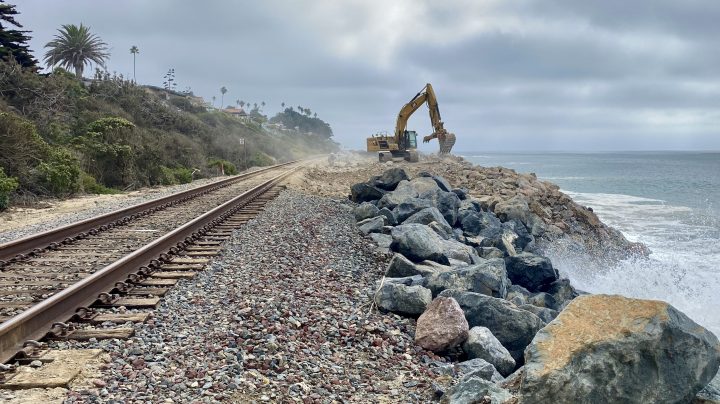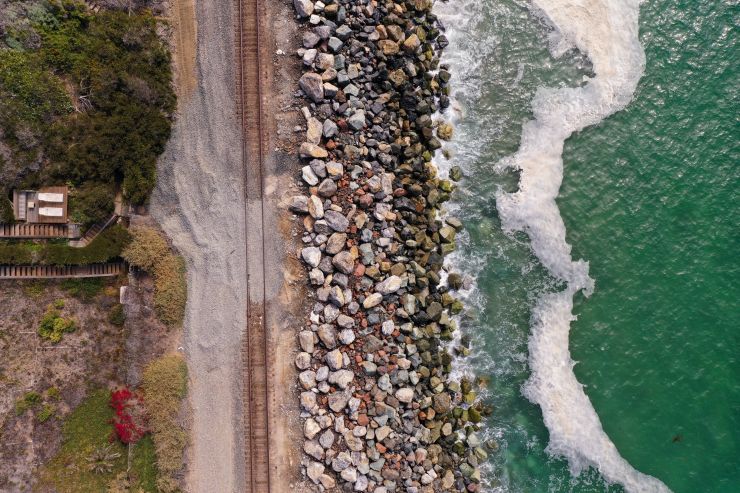
A Southern California town reckons with its disappearing beaches
A Southern California town reckons with its disappearing beaches

On a sunny fall morning, waves crashed against a slope made up of huge boulders, or riprap, sending spray over the adjacent railroad tracks. These tracks, south of San Clemente State Beach in Southern California, are part of the only freight rail line that connects the Port of San Diego with the rest of the country. This is also the route of the popular Amtrak Surfliner that hugs the coast all the way up to San Luis Obispo in Central California.
But in late September, authorities shut down passenger rail service and slowed freight service through San Clemente because the tracks here are in danger of sliding into the ocean.
“You just got Mother Nature at work on two sides,” said Darrell Johnson, CEO of the Orange County Transportation Authority, the county’s transit planning commission. “On the ocean side, you’ve got sea-level rise, higher tide, storm surges. We had Hurricane Kay in the early part of September.”
And on the inland side of the tracks, the slope is eroding — pushing the tracks outward more than 2 feet in the past year or so.
Southern California’s economy and identity are intimately tied to its beaches. But the coast is now facing a reckoning with its history of beachfront development and the climate crisis, and that’s all coming to a head along this iconic rail line.
The transportation authority’s short-term plan to secure the tracks is to pile up more riprap to hold back the waves and drive giant stakes, called soil nails, into the bedrock to try to stabilize the slope.
“This is clearly some type of interim solution,” Johnson said. “The question is: Is it, you know, measured in years or decades?”
It’s not just the railroad tracks that are threatened. Some of the homes above the tracks have already been deemed uninhabitable.
But this shoreline wasn’t always so vulnerable. There used to be a wide beach here between the train tracks and the ocean.
“They had volleyball courts, there were showers,” said Debbie Sheldrake, who’s been surfing off this coast for 30 years. “None of that is there anymore, it’s all gone.”
Sand helps buffer the coast from storms, like a referee keeping the sometimes wild Pacific Ocean at arm’s length — or beach’s length. It keeps the waves from digging into the base of coastal bluffs.
So what happened to all that sand? The ocean has been sucking up sand faster than it can be replaced, according to Brett Sanders, a professor of civil and environmental engineering at the University of California, Irvine. Besides storm surges and sea-level rise, there’s also an inland side to the problem, he said.
“We’ve kind of been slowly starving our coasts of the sediment supply that it needs to be healthy and resilient,” Sanders said.

For one thing, concrete and landscaping trap sediment that otherwise can be washed out to the ocean and become sand. And then there’s California’s ongoing drought.
“Because of our drought, we haven’t had storms, big storms washing sediment to the coast at the rate we have in the past,” Sanders said.
The state and federal government have replenished beach sand in other parts of California over the years. San Clemente’s main beach is scheduled to get a load of sand next fall — 250,000 cubic yards at a cost of $15.1 million.
San Clemente Mayor Pro Tem Chris Duncan wants more solutions like this to protect the town’s vulnerable coastline. If the beach disappears, he said, so does the town’s whole reason for being.
“The identity of the town and the economy of the town are completely and totally tied to the beach,” Duncan said. “It’s part of the heart and soul of people who live in San Clemente.”
The train does bring tourists to the town, Duncan said, and some San Clemente residents use it to commute to Los Angeles and elsewhere. But without a long-term plan to protect the coast, he doesn’t see how the tracks are any match for Mother Nature.
There’s a lot happening in the world. Through it all, Marketplace is here for you.
You rely on Marketplace to break down the world’s events and tell you how it affects you in a fact-based, approachable way. We rely on your financial support to keep making that possible.
Your donation today powers the independent journalism that you rely on. For just $5/month, you can help sustain Marketplace so we can keep reporting on the things that matter to you.

















